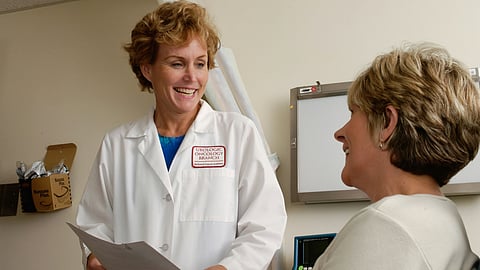

Remote supervision, using telemedicine technology, is comparable to in-person oversight of medical students, according to researchers at Philadelphia College of Osteopathic Medicine (PCOM) who measured learning outcomes of student-trainees in a post-acute/long-term care setting.
The study, published in the Journal of the American Medical Directors Association, measured outcomes of 167 fourth-year PCOM Doctor of Osteopathic Medicine students at a teaching nursing home. A faculty geriatrician accompanied half the students to patient visits and held debriefings in person while an off-site physician observed and debriefed with the other half of students through a workstation on wheels. This telemedicine cart included capabilities such as a pulse oximeter, zoom camera and videoconferencing that allowed the faculty member to observe and comment on the students’ interactions with patients.
Researchers measured learning outcomes in the areas of patient rapport, empathetic attitudes, medical knowledge, and behavior (such as professionalism, communication, and teamwork) and found that there “were no differences between the face-to-face supervision and telemedicine supervision across the four evaluation types.”
Senior author Katherine E. Galluzzi, DO, CMD, chair of PCOM’s Department of Geriatric and Palliative Medicine, said the study contributes to a relative lack of research regarding the effectiveness of remote supervision of medical students even amid the sharp rise in telemedicine delivery of patient care over the past few years.
“The world has changed irrevocably since COVID. We have to embrace this change instead of being afraid of it,” Galluzzi said. “We have to leverage technology so that it improves the types of experiences and educational opportunities we give our medical students.”
Galluzzi was also motivated to leverage the novelty of remote supervision in the post-acute/long-term care setting to spark greater interest in students choosing geriatrics as a specialty. According to the American Geriatrics Society, there are just over 8,000 full-time practicing geriatricians nationally, and demand is projected to outstrip supply as the U.S. population ages.
The researchers conclude their study by noting that technology can impose barriers to face-to-face care by, for example, having physicians spend considerable time updating electronic health records. This may be offset through “appropriate use of telemedicine to synchronously supervise medical students’ patient encounters,” which the authors say is like “fighting fire with fire.”
Galluzzi envisions a day where a faculty geriatrician can oversee multiple patient encounters remotely via a split-screen TV, zooming in on one room when a student has a question.
Although the research team did not poll patient satisfaction, Galluzzi said she noticed buy-in. “I was surprised for them to see me on the screen, wave to me and say, ‘Hey doc, how you are you doing?’” Galluzzi said. “The connection was really palpable.”
Nicol E. Joseph, DO, CMD, a professor in PCOM’s Department of Geriatric and Palliative Medicine, is the study’s first author.
(Newswise/SD)
